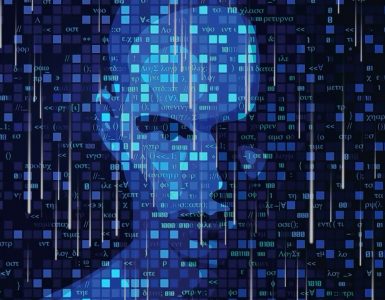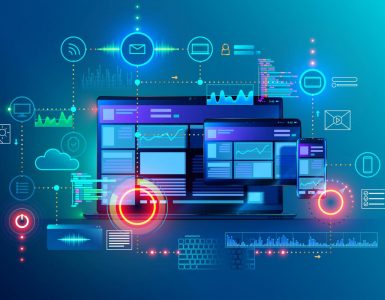Apple Vision Pro and visionOS – An Overview
Apple’s foray into spatial computing, through the introduction of Vision Pro and its accompanying visionOS, signifies a groundbreaking shift in computing paradigms. With the tech giant’s reputation for blending design with functionality, these innovations are poised to reshape how users perceive and interact with digital content.
Spatial Computing Defined
Spatial computing transcends the limitations of conventional 2D interfaces. Instead of flat displays and point-click interfaces, spatial computing offers a three-dimensional digital environment. This immersion allows for interactions that mimic real-world dynamics. A user can “reach out” to grab a file, “look around” a digital workspace, or “walk” through a digital gallery. By blurring the lines between physical and digital realities, spatial computing offers more intuitive and holistic user experiences.
Inside the Apple Vision Pro
At the core of Apple Vision Pro’s functionality is its ability to create a dynamic 3D representation of the user’s environment.
Head-mounted display (HMD): Unlike traditional screens, the Vision Pro’s HMD immerses users in a 3D digital world. The visuals adjust based on users’ head movements in real time, ensuring a consistent and smooth experience.
Sensors: Vision Pro incorporates an array of advanced sensors: these track head movements, eye gaze, and even hand gestures. The precision of these sensors ensures a seamless blend of the real and digital realms.
Rendering: By processing sensor inputs, Vision Pro can render 3D visuals that align with the user’s perspective, giving a natural feel to interactions.
visionOS – The Power Behind the Vision
Taking cues from Apple’s existing ecosystem of macOS, iOS, and iPadOS, visionOS is tailored for the 3D experiences of spatial computing.
3D Interface: Traditional icons and windows are transformed into spatial elements. Files appear as objects on a virtual desk, and applications could be represented as rooms or structures.
Multi-modal Interactions: VisionOS isn’t just about visuals. Users can control the system using their eyes, which might be employed to focus on specific data points, hands for more tactile interactions, and voice commands to navigate or initiate tasks.
Integrated Ecosystem: Being part of the Apple family, visionOS would likely have synergy with other Apple devices and services, ensuring continuity of experience across devices.
Some of the key features of visionOS include:
A brand-new three-dimensional interface: visionOS features a brand-new three-dimensional interface that users can magically control with their eyes, hands, and voice. Users can launch apps, select menus, and interact with content by simply looking at it.
EyeSight: EyeSight is an innovation that helps users stay connected with those around them. When a person approaches someone wearing Vision Pro, the device feels transparent — letting the user see them while also displaying the user’s eyes. This allows users to have more natural and engaging interactions with the people around them, even when they are wearing a headset.
Spectrum of immersion: visionOS apps can be launched in a windowed mode, where they appear alongside other apps on the user’s desktop. They can also be launched in a fully immersive mode, where the user is completely surrounded by the app’s content. This gives users the flexibility to choose the level of immersion that is right for them, depending on the task at hand.
Compatibility with existing iPad and iPhone apps: visionOS is compatible with existing iPad and iPhone apps. This means that developers can easily port their existing apps to visionOS, without having to start from scratch.
Accessibility features: visionOS has been designed with accessibility in mind. Users can interact with visionOS using a variety of methods, including their eyes, voice, and a combination of both. This makes visionOS accessible to everyone, regardless of their abilities.
What are the benefits of Apple Vision Pro and visionOS?
Apple Vision Pro and visionOS have the potential to revolutionize the way we interact with computers. Some of the benefits of these technologies include:
More immersive and engaging experiences: visionOS apps can create more immersive and engaging experiences than traditional two-dimensional apps. This is because visionOS apps can surround the user with content, and users can interact with the content in a more natural and intuitive way.
Increased productivity and efficiency: visionOS apps can also help users to be more productive and efficient. This is because visionOS apps can provide users with more information and tools at once, and users can interact with these apps more quickly and easily.
New creative possibilities: visionOS opens up new creative possibilities for developers and artists. visionOS apps can be used to create new forms of entertainment, education, and productivity tools.
What are the potential applications of Apple Vision Pro and visionOS?
Gaming
One of the most obvious applications for Apple Vision Pro and visionOS is gaming. Spatial computing can be used to create immersive 3D games that players can interact with using their eyes, hands, and voice. This could lead to a new generation of games that are more realistic and engaging than ever before.
For example, imagine a game where you are a pilot of a fighter jet. You could use your eyes to look around the cockpit and see your surroundings in 360 degrees. You could use your hands to control the jet’s controls, and you could use your voice to communicate with your teammates.
Education
Another promising application for Apple Vision Pro and visionOS is education. Spatial computing can be used to create educational experiences that are more interactive and engaging than traditional methods.
For example, imagine a student learning about the human anatomy. They could use Apple Vision Pro to view a 3D model of the human body. They could zoom in and out, and rotate the model to see it from different angles. They could even interact with the model to learn about different parts of the body.
Productivity
Apple Vision Pro and visionOS could also be used to improve productivity in the workplace. For example, spatial computing could be used to create new tools for collaboration and communication.
For example imagine a sales team giving a presentation to a potential customer. They could use Apple Vision Pro to create an immersive presentation that surrounds the customer with content. They could interact with the customer in real-time to answer their questions and address their concerns.
Creativity
Spatial computing could also be used to open up new creative possibilities for artists and designers. For example, spatial computing could be used to create new forms of art and entertainment.
For example, imagine a filmmaker creating a movie using Apple Vision Pro. They could use spatial computing to create immersive 3D scenes that the viewer can explore. They could even use spatial computing to create interactive movies that the viewer can control.
Conclusion
Apple Vision Pro and visionOS are two of the most exciting new technologies in development today. They have the potential to revolutionize the way we interact with computers, games, education, and the workplace.
Spatial computing can be used to create immersive 3D experiences that users can interact with using their eyes, hands, and voice. This could lead to a new generation of games, educational experiences, and productivity tools that are more realistic, engaging, and effective than ever before.
Apple Vision Pro and visionOS are still under development, but they have the potential to change the way we live and work. I am excited to see what the future holds for these technologies.






Add comment